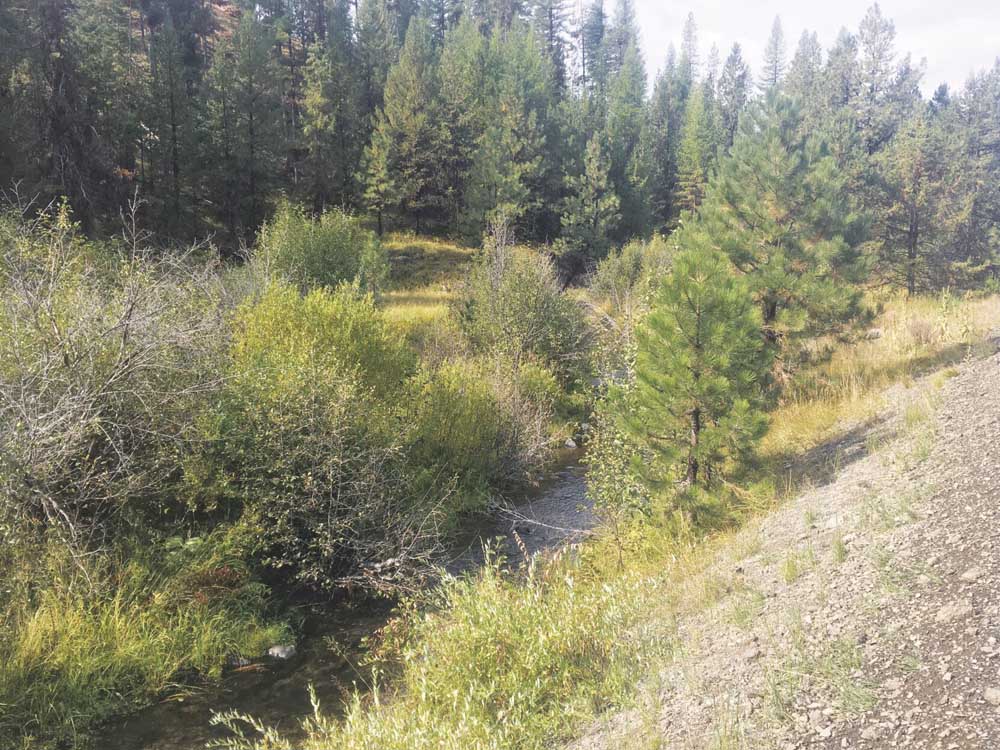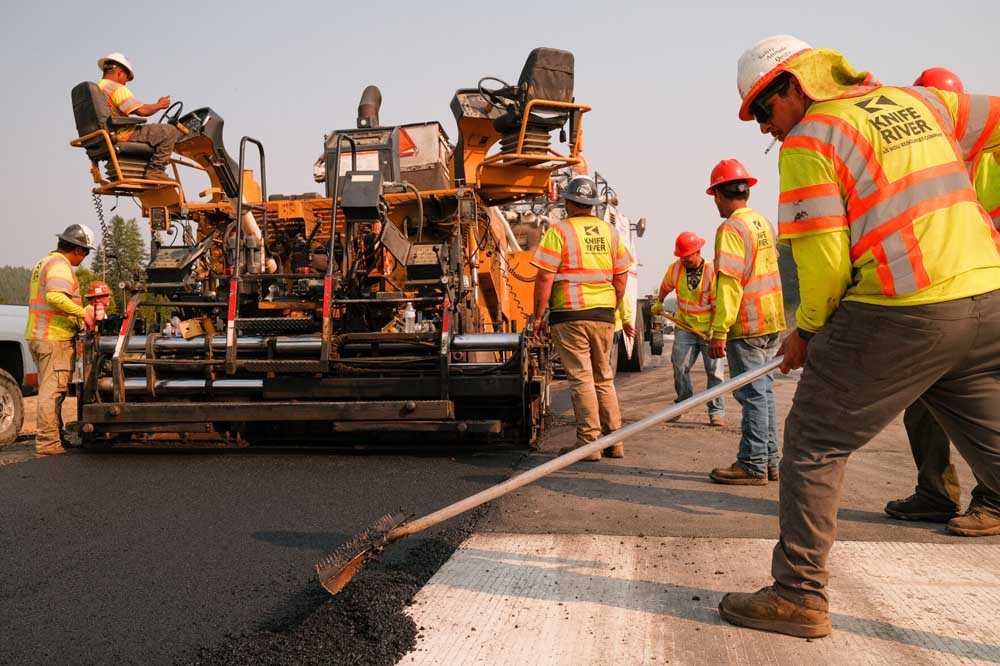Tribes plan to restore dredged stream near Granite
Published 12:00 pm Wednesday, January 25, 2023

- Bull Run Creek flows near Granite.
GRANITE — The Confederated Tribes of the Umatilla Indian Reservation are working with two partnering agencies to try to restore a section of stream near Granite that is spawning habitat for chinook salmon and was altered by gold dredging more than a century ago.
The stream is Bull Run Creek.
It’s a tributary of Granite Creek and the North Fork John Day River.
The tribes, based in Pendleton, are focusing on a 2-mile reach of Bull Run Creek, about 2 miles southeast of Granite, where historic dredging churned the stream’s floodplain and confined the stream between layers of gravel and stones known as tailings, making the stream less suitable as habitat for salmon and other fish.
Mining resulted in a creek channel that is straight rather than meandering, and it narrowed the historic floodplain from an estimated 150 to 200 feet wide to just 25 to 30 feet now, said John Zakrajsek, a habitat biologist for the tribes.
“That’s not what we’d expect in a natural setting,” Zakrajsek said.
The changes wrought by dredging are especially apparent in the lower reaches of the project, where the valley widens and where the floodplain would have also broadened in the past, he said.
The tribes, along with the North Fork John Day Watershed Council (a nonprofit organization based in Long Creek) and the Wallowa-Whitman National Forest, are working on a proposed two-phase restoration project, all on public land, that Zakrajsek hopes will start this summer on Bull Run Creek, which the tribes know as Kuckucéepe téekin.
The section is near where a smaller stream, Boundary Creek, joins with Bull Run Creek. That site is close to Boundary Guard Station, a historic Forest Service cabin.
The basic concept is to dig up some of the tailings and add meanders to the creek channel. Now, the channel flows between piles of tailings that in places rise 10 feet or more above the water and, in effect, lock the stream in place, Zakrajsek said.
“It’s just stuck,” he said.
Workers will also place logs and other wood debris in the channel to replicate a natural condition. That debris can slow the water flow and reduce erosion, and, combined with the debris, create pools that are refuges for fish.
The concept also calls for planting hardwoods such as willows along the newly contoured stream channel, which create shade that can keep water temperatures lower during the summer, also a boon for fish.
The project covers about 10 acres along the creek.
The goal is to reconnect the stream to its floodplain, said Alex Rice, a project manager for the North Fork John Day Watershed Council.
With the creek confined to its straight, narrow channel cut through the tailings, the water doesn’t spread, creating the sort of wide floodplain with wetlands that would have been there prior to the dredging, Rice said.
“We’re really excited,” he said. “It’s one of the biggest projects we’ve engaged in. It will benefit fish populations as well as improve water quality.”
He noted that on the tailings themselves, the predominant plants are ones that can tolerate dry, rocky soils, such as lodgepole pines. Deciduous trees, mainly willows and alders, are confined to a narrow strip right along the creek.
“In a natural system like this the floodplain should be all species that can tolerate wet conditions such as willows, alders, cottonwoods and some spruce,” Rice said.
Stream plays a role in tribes’ history
For the tribes, restoring the stream is both an environmental and a cultural project, Zakrajsek said.
As hunter-gatherers, the tribes — the Cayuse, Umatilla and Walla Walla — moved around the region following their food sources, he said.
Salmon and other fish were vital sources both for sustenance and for tribal ceremonies.
Zakrajsek said Oregon Department of Fish and Wildlife surveys have shown that chinook salmon spawn in Bull Run Creek. One objective of the pending project is to improve the habitat through the tailings, which could open upstream reaches of the creek to spawning.
Although ODFW doesn’t survey for spawning steelhead, Zakrajsek said it’s likely that those anadromous fish — rainbow trout that migrate to and from the Pacific Ocean, like salmon — also inhabit Bull Run Creek.
The stream is also habitat for bull trout, a threatened species under the federal Endangered Species Act, and Zakrajsek said it’s probable that Pacific lamprey, an eel-like fish, also live in the creek.
Zakrajsek said adding wood debris and creating meanders should create pools where the deeper water stays cooler. That’s especially important for bull trout, he said, as those fish — actually a type of char, not a true trout — are even more sensitive than salmon and steelhead to warm water.
Zakrajsek said bull trout probably don’t stay in Bull Run Creek during summer because the water is too warm, instead migrating into cooler water in higher-elevation tributaries.
Rice said the project’s estimated cost is $1.6 million.
Zakrajsek said the tribes, who are overseeing the project, have secured about $722,000 from two sources — the Oregon Watershed Enhancement Board and the National Fish and Wildlife Federation, a federal agency. The tribes are also waiting for official word about funding from the Bonneville Power Administration and the U.S. Forest Service, he said.
The tribes will hire a contractor to do the restoration work.
The first phase, which is tentatively slated to start this summer, includes removing about 55,000 cubic yards of tailings, Zakrajsek said.
Rice said some of that material will be used in the floodplain. Excess tailings will be hauled to a nearby quarry to be crushed into gravel for local road work.
Zakrajsek said the project is designed in two phases, with one year in between. If the first phase, as he hopes, happens this year, the second would take place in 2025.
A series of restoration projects
The Bull Run Creek work is the latest in a series of restoration jobs tied to a 2011 Forest Service study about the effects of mining in the Granite Creek watershed, Zakrajsek said.
During the past decade or so, the tribes have worked to restore another section of mine tailings along Granite Creek west of La Grande, he said.
The Forest Service has also replaced several culverts, including one along Bull Run Creek, to make it easier for salmon to navigate upstream.
Bull Run Creek is an important stream, Rice said, in part because it starts at a relatively high elevation and has cool water that’s vital for salmon, steelhead and bull trout.
The stream starts at a spring near Blue Springs Summit, along the Sumpter-Granite Highway. Several tributaries empty into Bull Run Creek before its confluence with Granite Creek just west of the town of Granite, including Deep, Corral and Boundary creeks.






